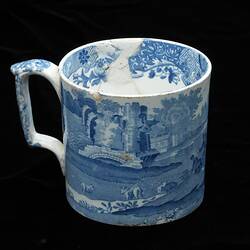Summary
This Willow pattern platter has been reconstructed from 14 fragments which were excavated at one of the digs on the Commonwealth Block between 1988 and 2003. It was manufactured at Daisy Banks, Longton, Staffordshire, England between 1853 and 1868 by Hulse, Nixon & Adderley.
Homewares.
Numerous crockery pieces were found all over the Little Lon site. Crockery gives us a glimpse of everyday life in Melbourne in the 1880s. In the houses around Little Lon, residents used decorated crockery. Most pieces were cheap earthenware or stoneware, yet provided colour and cheer. Only a few could afford to buy matching sets, and most china was probably acquired second-hand. Some were once expensive pieces. Householders mixed and matched their crockery from the great range of mass-produced designs available. 'Blue and white' and the 'willow' pattern, was the most popular choice and was produced by English potteries from 1790.
Physical Description
This is a platter which has been reconstructed from14 fragments. It has a feathered edge and a neutral glaze. It is decorated with a blue on white underglaze transfer printed Willow pattern. There is a manufacturer's mark on the base, which includes a crown and the Staffordshire knot.
Physical Description
14 pieces of platter, blue on white underglaze transfer printed willow pattern. Feathered edge. Neutral glaze, underglaze transfer print AS B12, M-7.5 PB2/8. Dimensions 320 x 260mm. Reconstituted to be about 92% complete supplementary file contains information about the Willow Pattern.
More Information
-
Collection Names
-
Collecting Areas
-
Acquisition Information
Transfer from Heritage Victoria, Industry Superannuation Property Trust, 03 May 2005
-
Manufacture Name
-
Manufacture Date
-
Manufacturer
Hulse, Nixon & Adderley, Daisy Banks, Longton, Staffordshire, England, Great Britain, 1853-1868
-
Inscriptions
On base: 'STAFFORDSHIRE/STONE/CHINH. N. &. A' with a crown and the staffordshire knot (TP).
-
Context Number
27/23
-
Site
[TCS] Australia, Victoria, Commonwealth Block, Melbourne
-
Activity
-
Specific Activity
-
Decoration
-
Colour
Blue
-
Moulding
Willow
-
Form
Curved Marly Rim; Flat (Base)
-
Shape
Ovoid, Indented
-
Technique
-
Provenance
England, Staffordshire
-
Classification
-
Category
-
Discipline
-
Type of item
-
Exhibition Collection Management
254 mm (Length), 315 mm (Width), 42 mm (Height)
-
Dimensions
3.5 cm (Length), 27 cm (Width), 32 cm (Height)
Measurement From Conservation.
-
EAMC Measurements
320 (Length), 260 (Width)
-
References
Lisa-Mairi Smith: An exploration of nineteenth century ceramics.
86 Pages
-
Keywords


